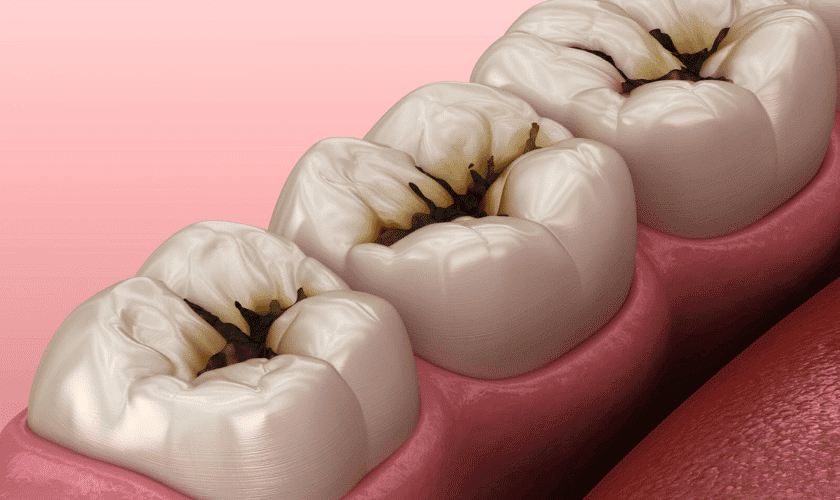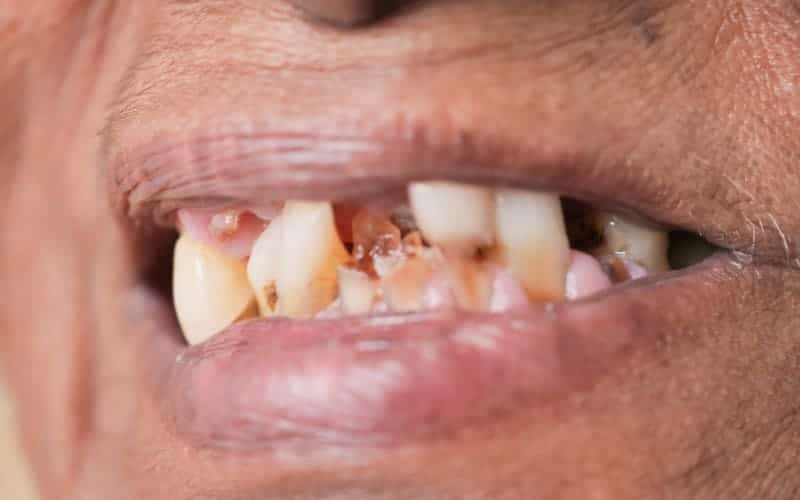
How Long Can A Tooth Cavity Go Untreated?
A tooth cavity, or dental caries or decay, is a localized area of damage to the tooth’s hard tissues, primarily caused by bacterial activity.
When sugars and starches in food interact with bacteria in the mouth, they produce acid that erodes the tooth enamel.
Over time, this process leads to the formation of cavities, compromising the tooth’s structure.
Initial symptoms may include sensitivity to hot and cold sensations. If not treated, cavities can worsen and lead to pain, infection, and even tooth loss.
Prevention involves regular dental hygiene, fluoride use, and dietary modifications to minimize sugar intake.
Causes of Tooth Cavities
1. Bacteria: The primary cause of tooth cavities is the presence of bacteria in the mouth, notably Streptococcus mutans. These bacteria interact with sugars and starches from food, producing acids that erode tooth enamel.
2. Poor Oral Hygiene: Inadequate brushing and flossing allow plaque accumulation—a sticky film of bacteria and debris—on teeth. Plaque contributes to acid formation, promoting the development of cavities.
3. Diet: Consuming sugary and acidic foods and beverages fuels bacteria, accelerating the production of acids that attack tooth enamel. Frequent snacking on such items increases the risk of cavities.
4. Lack of Fluoride: Fluoride helps strengthen tooth enamel and resist acid attacks. The risk of cavities may be higher in areas with low fluoride levels in water or inadequate use of fluoride toothpaste.
5. Dry Mouth: Saliva is crucial in neutralizing acids and maintaining oral health. Conditions that reduce saliva flow, such as certain medications or medical conditions, can increase susceptibility to cavities.
Signs and Symptoms of an Untreated Cavity
1. Toothache: Persistent or spontaneous tooth pain, especially when eating or drinking hot, cold, or sweet items, can indicate an untreated cavity. As the decay progresses and reaches the tooth’s inner layers, it can increase sensitivity.
2. Visible Holes or Pits: Untreated cavities can eventually cause visible damage to the tooth structure. Small holes or pits may become noticeable on the tooth’s surface, indicating advanced decay.
3. Tooth Discoloration: Discoloration, such as white spots or darkening of the tooth, may occur as the cavity advances. This color change is often a sign of mineral loss and damage to the tooth structure.
4. Bad Breath (Halitosis): Bacteria associated with cavities produce foul-smelling byproducts. Untreated cavities can contribute to persistent bad breath, even after practicing good oral hygiene.
Also Read: How To Stop Bad Breath From the Mouth?
5. Pus around the Tooth: In severe cases, untreated cavities can lead to dental abscesses. Pus accumulation around the affected tooth may cause swelling, redness, and throbbing pain in the affected area, indicating a severe infection that requires prompt dental attention.
How Long Can a Tooth Cavity Go Untreated?
The progression of a tooth cavity varies depending on several factors, including the individual’s oral hygiene, diet, and the specific characteristics of the hole. Generally, a niche can go untreated for an extended period, but the consequences become more severe.
Initially, a minor cavity may not cause noticeable symptoms, allowing it to remain untreated for months or even years.
However, as the decay advances, it can reach the tooth’s inner layers, leading to pain, sensitivity, and potential infection. Untreated cavities can eventually result in tooth loss or the need for more extensive and costly dental procedures.
It’s crucial to address cavities promptly through regular dental check-ups and early intervention.
Risks of Leaving a Cavity Untreated
1. Pain and Discomfort: Untreated cavities can progress, reaching the sensitive inner layers of the tooth, causing pain and discomfort. This can interfere with daily activities such as eating and drinking and may lead to persistent, throbbing toothaches.
2. Infection (Abscess): Advanced cavities can result in bacterial infection, forming an abscess—a painful pocket of pus around the tooth. Dental abscesses can cause severe swelling and fever and may spread to other parts of the body if left untreated, posing a risk to overall health.
3. Tooth Loss: If the decay continues to progress without intervention, it can eventually compromise the tooth’s structural integrity, leading to irreversible damage. In such cases, extraction may be the only viable option to prevent the spread of infection and preserve oral health.
4. Spread of Decay: Untreated cavities can affect neighboring teeth. Bacteria and acids from the cavity can spread to adjacent teeth, increasing the risk of additional cavities and dental problems.
5. Costly and Extensive Treatments: Delaying treatment worsens the cavity, potentially requiring more extensive and expensive dental procedures such as root canal therapy or tooth replacement options like dental implants or bridges.
Early intervention with simple therapeutic measures can help prevent the need for more complex treatments.
Prevention Techniques for Cavities
1. Regular Oral Hygiene: Brushing teeth at least twice daily with fluoride toothpaste helps remove plaque and prevents bacteria buildup that leads to cavities. Flossing daily is also crucial to clean between teeth and along the gumline.
Also Read: The Importance Of Regular Dental Checkups For A Healthy Smile
2. Balanced Diet: Limiting sugary and acidic foods reduces the availability of fuel for cavity-causing bacteria. Consuming a well-balanced diet that includes calcium-rich foods helps strengthen tooth enamel.
3. Fluoride Use: Fluoride, whether from toothpaste, mouthwash, or professional treatments, strengthens tooth enamel, making it more resistant to acid attacks. Using fluoride-containing dental products and drinking fluoridated water supports cavity prevention.
4. Regular Dental Check-ups: Routine dental visits allow for early detection of cavities and other dental issues. Professional cleanings and preventive treatments, such as dental sealants, can help protect teeth from decay.
5. Dental Sealants: Applying dental sealants to the chewing surfaces of molars creates a protective barrier that helps prevent bacteria and food particles from settling in the grooves and crevices, reducing the risk of cavities in these areas.
Pursuing cavity prevention, maintaining a robust oral hygiene routine, embracing a balanced diet, and prioritizing regular dental check-ups are paramount. Fluoride use, dental sealants, and adopting healthy habits like chewing sugar-free gum contribute to a resilient defense against cavities.
Singh Smile Care, a leading dental practice, advocates proactive oral health measures. For personalized prevention plans and expert care, trust Singh Smile Care to safeguard your smile. Choose prevention over intervention—because a healthy smile is a lasting one.
Schedule your appointment today and let Singh Smile Care be your partner in preserving dental wellness. Smile confidently, smile with Singh Smile Care!





